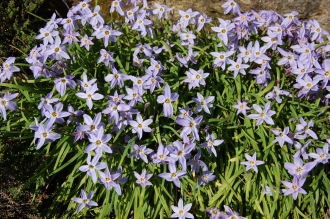Position: Full sun to light shade
Flowering period: Spring
Soil: Moist, well drained
Eventual Height: 20cm
Eventual Spread: 20cm
Hardiness: 5a, 5b, 6a, 6b, 7a, 7b, 8a, 8b, 9a, 9b
Family: Amaryllidaceae
Ipheion uniflorum is a bulbous herbaceous perennial with a tufted habit. Its mid green shiny leaves are strap like with entire margins and up to 30cm long. Its leaves smell of onions when crushed. Its pale lilac fragrant flowers are star shaped, up to 3cm long, 4cm across and appear singularly on erect stems. Its bulbs are up to 5cm across.
Ipheion uniflorum, commonly known as the Spring Star or Spring Starflower, is native to Argentina, Chile and Uruguay. It was introduced into the UK in 1820. Ipheion uniflorum is synonymous with Tristagma uniflorum.
The etymological root of the binomial name Ipheion is unclear, possibly from iphyon a name given by Theophrastus to a species of Lavender. Uniflorum is derived from the Latin unum meaning single’ and flora ‘the goddess of flowers’
The landscape architect may find Ipheion uniflorum useful when planted en mass or naturalised in grass. This plant dies down in early summer.
Ecologically, Ipheion uniflorum flowers are attractive to pollinating insects.
The Royal Horticultural Society has given the varieties Ipheion uniflorum ‘Froyle Mill’ and Ipheion uniflorum ‘Wisley Blue’ their prestigious Award of Garden Merit in 1993.
Ipheion uniflorum prefers moist, fertile, well-drained soils. It tolerates most pH of soil. It dislikes wet soils.
Ipheion uniflorum requires little maintenance. Large clumps may be lifted and divided in late summer.






Leave a comment